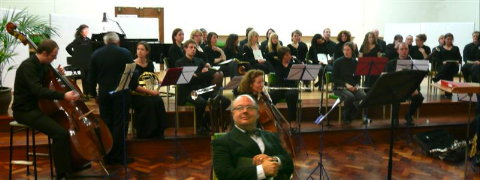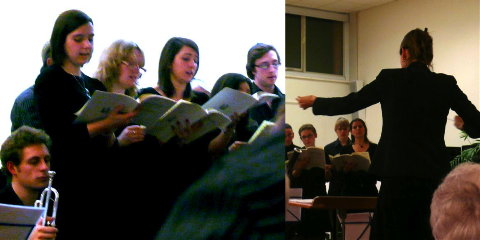|

New Colours
Leslie Anne Lewis conducts
a new chamber ensemble arrangement
of Bloch's 'Sacred Service',
reviewed by MALCOLM MILLER
A moving performance of Bloch's Sacred Service in a new chamber ensemble arrangement by the American composer Susan Peck, here receiving its UK première, formed the centrepiece of a memorable concert on 12 February 2009 as part of the International Bloch Jubilee Festival, to mark the fiftieth anniversary of Bloch's death. The concert was given at the Digby Stuart College Chapel, Roehampton University, London UK (repeated on 14 February at the Wimbledon Synagogue) with Cantor Colin Schachat and Leslie Anne Lewis conducting the Roehampton University Chamber Choir and Orchestra. The Sacred Service was preceded by aptly chosen popular chamber music by Bloch. The Three Pieces from Jewish Life received an impassioned and tender account by the cellist Babette Lichtenstein and pianist Anthea Fry, followed by the Baal Shem Suite, in which the violinist Rachel Erdos accompanied by Carlina Carr produced a silvery, singing account that captured just the right mood of intensity and yearning.

Members of the Roehampton University Chamber Choir and Orchestra. Photo © 2009 Caroline Silver Lewis
|
The idea for a Sacred Service stems from Bloch's early period in San Francisco, where he was Director of the Conservatoire, having emigrated to the USA from his native Switzerland in 1916. He was commissioned to set the Sabbath Morning Service of the American Union Prayer Book by Cantor Reuben Rinder of the San Francisco Temple Emmanuel, who introduced Bloch to several traditional melodies and modes, which he integrated within a distinctive post-Wagnerian, post-Debussyian harmonic style infused with the textures and techniques of renaissance polyphony. Michelle Sampson, a Roehampton University music student and Cantor, highlighted some of those 'Jewish' elements, such as liturgical texts, musical orientalisms and use of traditional sources, such as the 'Zur Yisrael', as well as the work's more general Jewish expression and Biblical grandeur. Yet the radical nature of the work lies in its universal expression; like Bach's Cantatas, it is both rooted in a particular form of communal worship yet communicates far beyond.
The main composition was undertaken in Switzerland between 1930 and 1933 (Bloch later returned to the USA in 1939, teaching at UCLA, Berkeley and making his home in Oregon until his death in 1959), and it was first performed in Italy in 1934, and exists in two versions, for orchestra or organ. Susan Peck's new version, for mixed ensemble, piano and organ, combined the drama and colour of the orchestration with the intimacy and accessibility of the organ only version. Indeed, much of the texture came across with revitalized clarity and rhythmic definition, helping to maintain momentum, and thus Peck's arrangement represents a highly effective version for choirs without the full orchestral resources.
The performance was enthralling throughout, the five sections unified by the powerfully evocative main motto, based on a mixolydian motif, which emerges at the very start. South African Cantor Colin Schahat, currently based in Israel, produced a noble baritone voice which added finesse and richness to the performance, and with Leslie Anne Lewis' spirited direction, the ensemble produced colourful support for the admirable choral singing of the RU Chamber Choir, well blended and alert to the brighter imitative choruses as to the more poetic, pastoral sections.

Leslie Anne Lewis conducting the Roehampton University Chamber Choir and Orchestra. Photo © 2009 Caroline Silver Lewis
|
The 'Mah Tovu' (How Beautiful) which opens Part I -- Meditation, flowed with bright choral homogeneity, with some enticing solos for flute, oboe, horn and piano. The brass element, intensified with dramatic tension at 'Shma Yisroel' ('Hear O Israel'), its arresting tritonal motif announced by the Cantor and echoed in the choir's dissonant harmonization, was especially thrilling. The instrumentation of the ensuing section sustained variety throughout the chorus, leading to the rhythmically vivid 'Mi Chamocha', where the Cantor again declaimed with clarity over low bass pedal-points.
One could appreciate Bloch's orientalism in the Cantor's 'Tzur Yisrael' echoed by the subdued chorus. The distinct character of each of the five Parts of the work was impressively conveyed, notably the colourful splendour of Part II -- 'Kedusha' (Sanctification), with its grandiose drama and use of cymbals, the dialogual sections and the final rhythmic choruses supported by a harmonic texture based on Bloch's characteristic device, shifting open fifths.
The dreamier Part III -- Silent Devotion, with its instrumental fugatos, introduced by flute and piano, displayed its more universal sacred style with plenty of drama at the Cantor's 'Seu Shearim' ('Lift up your heads, ye gates!) imitated in the vivid chorus. The instrumental fugato led to the dialogual textures of 'Taking the Scroll from the ark', culminating in a bright and major mode chorus enriched with brilliant brass textures. Part IV, 'Returning the Scroll to the Ark' resumed the chromatically sinewy bass lines to support declamatory Cantor solos, yet evolving some of the most lyrical passages for choir and Cantor, especially the 'Eitz Chayim Hi' (It is a Tree of Life) that concluded in peaceful calm, one of the expressive highpoints of the performance.
The final Part V, a reprise of the orchestral fugato built on the main motto, introduces a new element, a spoken Memorial prayer, which in this performance was not quite audible. Its orientalisms, including melismatic ornaments, open fifth harmonies, and powerful bass lines for the tuba, were atmospherically rendered. The final 'hymn' of Adon Olam' (Master of the World) formed a stirringly compelling climax. Its congregational setting is usually a bright and upbeat melody yet here Bloch chose a climactic and shifting style, complex and subtly varied, opening with an eerie harmonization, then leading to an elaborate trumpet solo and a Cantor solo at the highpoint, before a calm receding ending. All the more moving was the serene epilogue, 'Yeverechecha' (Benediction) with its sustained expressive calm.
The performance as a whole sustained tension and interest throughout, and was an admirable rendition of one of the major masterpieces of 20th century choral repertoire, a worthy tribute to a 20th century master whose oeuvre as a whole, much of it still unfamiliar, rewards deeper exploration and discovery.
Copyright © 21 April 2009
Malcolm Miller,
London UK

ERNEST BLOCH LESLIE ANNE LEWIS LONDON
|

